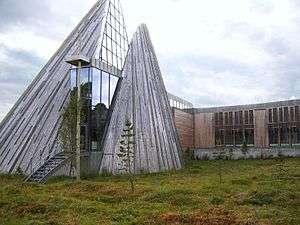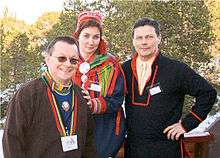Sámi politics
Sámi politics refers to politics that concern the ethnic group called Sámis in Norway, Sweden, Finland and Russia. In a more narrow sense, it has come to indicate the government of Sámi affairs by Sámi political institutions. This article deals with Sámi political structures, with an emphasis on the contemporary institutions.
Pre-parliamentarian Sámi politics
Nomadic times
Originally, the Sámi were semi-nomadic - moving between fixed settlements as the seasons passed. Several groups would often join up in the winter, making winter settlements (dálvvadis - n. sam) larger and more diverse than the spring-, summer- and autumn-settlements (the báiki - n.sam). In several dálvvadis, such as Jåhkamåhkke, large winter markets were established and towns grew up.
The "Finnekonger"
Norse sources from the 12th century and onwards, such as Heimskringla and Volundarkvida, talk about finnekonger ("Sámi kings"), which in contemporary history writing are interpreted as particularly wealthy Sámi, who were perhaps also chieftains. Archeological findings do indeed confirm that a certain degree of class society arose among the Sámi, due to the fur trade, in the early Middle Ages. Little is known about the formal status of the "finnekonger", however. The name is in any case misleading, as nobility has never been a part of Sámi culture.[1]
The Siida system
From old, the term siida (n. sam), refers to a unit of people who travel together and/or share a seasonal settlement. Väinö Tanners early 20th-century account of the workings in this polity refer to it as "primitive communism", as there was an extensive sharing of goods and land - though certain parts of the land was private, and not common to the siida's members. Norraz (e. sam), a meeting of all households' leaders, served as parliament, government and court.[2]
Other sources speak of siida-isids, people who were primus inter pares in the union of households. This person may be simply the head of the wealthiest or otherwise most successful household, a natural leader[3] or even elected by the council of families. They are sometimes referred to simply as "village elders".[4]
Elements of the siida system have survived among the Sámi who turned to reindeer herding and have remained semi-nomadic to this day.[5] Most Sámi, though, gradually settled down in villages from the middle of the 16th century. Reindeer herding and settlement in villages were different strategies aimed at countering the same problem: The extinction of undomesticated reindeer, which had been a key source of income for the nomadic groups.[6]
The Division of Sápmi (13th century - 1945s)
The Nordic states and the state of Novogorod soon began expanding northwards, dividing Sámi lands into spheres of interest. A system of joint taxation was established for parts of the Sámi area, so that f.ex. the Sámi between the Lyngen Alps and the White Sea needed to pay taxes to both Norway/Denmark–Norway and Novgorod/Grand Duchy of Moscow/Tsardom of Russia.[7] After the Time of Troubles and Kalmar War the borders became more concrete. In some areas, the Sámi still had to pay double taxes, though.[8] The 18th century saw a further division of Sámi lands, between Denmark–Norway and Sweden. The final agreement led to the creation of the Lapp Codicil of 1751 which admitted some rights to the indigenous people. Following the Napoleonic Wars, Norway was transferred from Denmark to Sweden; while Finland went from Sweden to Russia. This meant a transfer of most of the Sámi population from one sovereign to another. In 1826 the land border between Sweden-Norway and the Russian Empire in the northeast was finalized. While originally the siidas that were cut in two were to keep their rights on both sides of the border, this only lasted until Finland became sovereign and in 1920 got the Soviet Union's border regions with Norway. Norway then made an agreement with Finland, causing the split siidas to lose their now 'Norwegian' lands.[9] Following World War II, Finland lost the territories between Norway and the Soviet Union, leaving the borders as they are presently.
Early modern Sámi political organizing (c. 19th century-1950)
Russian Empire
In the mid-19th century, Czar Alexander II of Russia initiated wide-ranging reforms in democratic direction. During these reforms an assembly for the Sámi population was established on the Russian side of Sápmi, the Koladak Sobbar. This assembly would meet once a year in the town of Kola, to debate and even decide on certain issues of relevance for the indigenous people. It is unknown when this assembly stopped functioning, but it did in any case not survive the Russian Revolution.[10]
Nordic Countries
In the late 19th and early 20th centuries, a movement started in Norway's Finnmark and Troms counties, to save Sámi culture and language. Central people in these attempts were Per Fokstad and Isak Saba, both Coast Sámi. They were both activists in the Labour Party, which was one of the movements in Norway most positive to the Sámi cause at the time. Saba became the first Sámi elected to a national parliament in 1907. His poem Sámi soga lávlla would later be set to music and declared the official 'Song of the Sámi people'. In 1917, the first international Sámi conference took place in Trondheim, gathering North and South Sámi from Norway and Sweden. Two of the most important leaders in this movement were Elsa Laula Renberg and Daniel Mortensson, both South Sámi[11] This meeting to a large degree debated the problems of reindeer herding, and was important for the further development of the reindeer herding Sámi's organizing.[12] It also holds great symbolic value for the Sámi per se, and the official 'Sámi People's Day' was set to February 6, the date when the meeting began, to commemorate the occasion.
The Parliamentary structures
Modern Sámi politics are mainly based on the Sami Parliaments (Sámediggi in Northern Sami, Sämitigge in Inari Sami, Sää´mte´ǧǧ in Skolt Sami). These are representative bodies for peoples of Sámi heritage in Finland, Sweden and Norway. There is also an ongoing attempt to set up a Sámi Parliament in Russia. The three Sami Parliaments also have a common political framework called the Sámi Parliamentary Conference.
Finland
The Sami Parliament of Finland was opened on 2 March 1996, so far the last Sámi parliament to be inaugurated. However, in reality this parliament was based on an elected "Sámi delegation" which preceded all the other parliaments and inspired their creation. The parliament is situated in Aanaar. It currently has 21 representatives, who are elected every four years by direct vote from the municipalities in the Sami Domicile Area.
Norway

The Sami Parliament of Norway was opened on 9 October 1989, The seat is in Kárášjohka (Karasjok). It currently has 39 representatives, who are elected every four years by direct vote from 7 constituencies: Nuortaguovlu (Eastern region), Ávjovarri (Steep Mountain), Davveguovlu (North region), Gáiseguovlu (Mountainous region), Viestarmearra (Western Sea), Åarjiel-Saepmie (South Sápmi) and Lulli-Norga (South Norway). Unlike in Finland, the constituencies cover all of Norway - the last district encompassing the parts of Norway situated outside of Sápmi.
Sweden
The Sami Parliament of Sweden was opened on 26 August 1993. The seat is in Kiruna. The parliament has 31 representatives, elected every four years by general vote.
Russian Committee for a Sámi Parliament
On December 14, 2008 the 1st Congress of the Russian Sámi took place. The Conference decided to demand the formation of a Russian Sámi Parliament, to be elected by the local Sámi. A suggestion to have the Russian Federation pick representatives to the Parliament was voted down with a clear majority. The Congress also chose a Council of Representatives that were to work for the establishment of a Parliament, and otherwise represent the Russian Sámi.
Kuelnegk Soamet Sobbar (Kola Saami Assembly) was established in Murmansk December 12, 2010. Sámi Parliaments in Norway, Sweden, Finland have accepted the Kuelnegk Soamet Sobbar. The Russian government has not accepted the Russian Sámi Parliament. The Sami Parliament of Norway was opened in 1989. Representatives of Sami organizations in Russia have visited the Norwegian Sami Parliament in Karasjok to learn and want to learn more about the Norwegian Sami Parliament.[13][14][15][16]
Comparison of Sami Parliaments
Sami Parliament of Sweden is the representative body and run by the Swedish parliament. Sami Parliament of Sweden must comply with the decisions of the Swedish parliament.[17] Which sometimes goes against the elected Sámi Parliament Members' party programs. The Sami Parliament has no real power and the task is instead to enforce the decision of the Swedish parliament and government. Compare to the Sami Parliament of Sweden the is Kuelnegk Soamet Sobbar an initiative by the Russian Sámi, not a result by a government.
The Sámi Parliamentary Conference and Council
As of 2001, the parliaments have been united through the Sámi Parliamentary Conference. In this annual meeting, a plenary of all Sámi Parliamentarians meet - together with observators from the Sámi Council and the Russian Sámi associations. Between sessions, a Sámi Parliamentary Council operates.
The Presidents

The contemporary leaders of the Sámi people are the Sámi presidents. Each Sámi Parliament elects a President among their own numbers, so the Sámi political system today could be considered a cooperation between parliamentary democracies which are part of three sovereign states.
The Sámi Presidents cooperate through annual meetings, where the ministers responsible for Sámi affairs in Finland, Norway and Sweden also take part. These meetings are organized through the Nordic Council of Ministers. The formal leadership of the Sámi Parliamentary Council rotates between the Presidents.
The Finnish side
Current president on the Finnish side of Sápmi is Tiina Sanila-Aikio.[18]
The Norwegian side
Current president on the Norwegian side, and of the most powerful of the Sámi parliaments, is the North Sámi Aili Keskitalo, a civil servant and longtime Sámi politician from Guovdageaidnu. She represents the Norwegian Sami Association.[19]
The Swedish side
The chairman of the Board is also called the President of the Sami parliament.Current president is Stefan Mikaelsson.[20]
The Russian side
The committee to establish a Sámi Parliament in Russia, the Council of Plenipotentiary Representatives is headed by East Sámi Valentina V. Sovkina, whose background is from the organization AKS[5] There is also a parallel committee of Sami people elected by the regional authorities, headed by East Sámi Lyubov' Vatonena.
See also
References
- ↑ Hansen, Lars Ivar og Olsen, Bjørnar: Samenes historie fram til 1750. (Cappelen 2004): 125
- ↑ Hansen and Olsen 2004: 178-181
- ↑ The Indiana University Digital Library Program
- ↑ http://www.ub.uit.no/munin/bitstream/10037/1147/1/thesis.pdf
- ↑ The Indiana University Digital Library Program
- ↑ Hansen og Olsen 2004: 209
- ↑ Hansen, Lars Ivar and Olsen, Bjørnar (2004): Samenes historie fram til 1750, p. 169-175
- ↑ Hansen, Lars Ivar and Olsen, Bjørnar (2004): Samenes historie fram til 1750, p. 264-5, 274
- ↑ Sergejeva (Porsanger), Jelena: the Eastern Sámi: A short account of their history and identity in Acta Borealia vol. 17, 2-2000 p. 15-18.
- ↑ Berg-Nordlie, Mikkel: Eastern Sápmi - the Borderland and its people (NIBR International Blog 12.05.10), citing Kalstad, Yokhan Al’bert: Dorogoy Nadezhd. Politika Rossiyskogo gosudarstva i polozhenie saamskogo naroda v Rossii (1864–2003). (Murmanskoye Knizhnoye Izdatel’stvo 2009).
- ↑ Regnor Jernsletten: "Trondheimsmøtet 1917 og samebevegelsen". I Årjel Saemieh - Samer i Sør, årbok nr. 4, Snåsa 1991.
- ↑ Berg, Bård A: Mot en korporativ reindrift. (Dieđut 2/2000, p. 139-143).
- ↑ http://www.nrk.no/nett-tv/klipp/739247/ Oddasat - nyheter på samisk 23.05.2011
- ↑ http://www.barentsobserver.com/fighting-for-sami-parliament-in-russia.4530696-16149.html Fighting for Sami parliament in Russia
- ↑ http://www.barentsindigenous.org/saami-assembly-in-murmansk-oblast.4860165-111496.html Saami Assembly in Murmansk Oblast
- ↑ http://russia-media.ru/schlagzeilen/morenews.php?iditem=5260 http://russia-media.ru/schlagzeilen/morenews.php?iditem=5260
- ↑ "Sametinget har ingen egentlig makt". Sveriges Radio. datum=08 may 2005. Retrieved 1 February 2012. Check date values in:
|date=(help) - ↑ http://www.samediggi.fi/index.php?option=com_content&task=blogcategory&id=127&Itemid=222
- ↑ http://www.sametinget.no/Om-Sametinget/Representanter/Aili-Keskitalo
- ↑ http://www.samediggi.se/1072